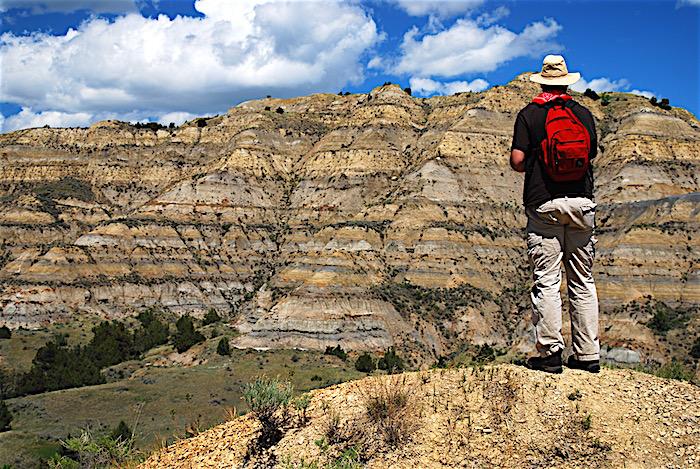
While Verizon Wireless will have its cell phone equipment on a new communication tower at Theodore Roosevelt National Park, the signal will not bleed into the park's officially designated wilderness/Kurt Repanshek file photo
A new communication tower is going up at the North Unit of Theodore Roosevelt National Park in North Dakota, and while Verizon Wireless will have equipment on the tower, it has been designed not to bleed a cell signal into official wilderness in the park.
The issue of a signal bleed was raised last fall by Public Employees for Environmental Responsibility, which worried that Verizon's signal from the tower would "blanket designated wilderness with cell phone coverage."
National Park Service staff recently issued a Final Environmental Assessment and Finding of No Significant Impact for the tower, which is a replacement. The current tower provides communication functions essential to public safety and efficient operations for the park and the U.S. Forest Service. The NPS will issue Verizon Wireless a right-of-way permit to co-locate their cellular equipment and replace the existing NPS communications tower northeast of the park entrance and east of U.S. 85.
Verizon Wireless initially proposed construction of a cellular communication tower on private lands near the park’s existing communication tower. The NPS and Verizon Wireless have determined that only one tower is needed to provide radio service to the NPS and USFS while providing cellular service for the U.S. 85 corridor. The new 190-foot high guyed tower will replace the existing 220 foot high guyed tower, eliminating the need for aviation safety lighting. Verizon Wireless will co-locate its telecommunications equipment on the tower and construct a slightly larger support shed to accommodate NPS, USFS, and Verizon equipment.
Park managers have successfully collaborated with companies in western North Dakota to reduce impacts to scenery, dark night skies, and natural sound.
“Verizon Wireless cooperated with the park to address concerns raised with the company’s proposal for installation of an additional communication tower near the park,” said Superintendent Wendy Ross. “The company’s willingness to work with the park in reducing light pollution and tower proliferation improves the North Unit visitor experience.”
Public comments during the EA review raised concerns about cellular phone service bleeding into designated wilderness areas, creating potential cell phone use conflicts between wilderness users. In response to these concerns, Verizon Wireless cellular equipment will only target the U.S. 85 corridor and will not provide additional cell service in designated wilderness areas.
The FONSI establishes that there would be no significant impact on the environment as a result of the selected action. The Final EA and the FONSI will be available through the NPS Planning

 Support Essential Coverage of Essential Places
Support Essential Coverage of Essential Places







Comments
Just another example of how silly PEER can be in their environmental extremism.
Perhaps, EC, but after PEER raised their concerns the NPS and Verizon worked it out to direct their signal down the U.S. 85 corridor and keep it out of wilderness.
And what did that accomplish other than denying service to some who would like it in the park and perhaps even putting lives at risk because of an in ability to contact help?
Well, I guess if you want to be assured of cell coverage, you don't go into wilderness. How did we ever manage to survive those pre-cell phone days?
I have to admit that I have very mixed feelings about this. I was just "rescued" in Big Bend when the water pump on my truck failed at Rio Grande Village Campground. There's no cell phone coverage there which makes it wonderfully peaceful but it was only with help from the campground host using an NPS landline that I was able to contact AAA. I could've been in a world of hurt if this had happened out on a remote back road somewhere. The nearest tow truck had to come from nearly 200 miles away to tow me and my trailer 120 miles to Alpine, Texas where the nearest mechanic was located.
The real problem probably isn't cell phone signals bouncing off the rocks but a few inconsiderate slobs who don't know how to keep the volume of their conversations down to dull roar. Cell phones have made a lot of national park experiences, such is watching an eruption of Old Faithful, nearly nightmarish experiences. Maybe what we need to do is to make inconsiderate use of cell phones a cause for justifiable homicide.
Argalite - that was at the same time callous and incoherent. Would you like to try again?
I dunno, Rick, I think his mix of satire and hyperbole pretty much hit the mark. I vote for the precautionary principle.
Glad Verizon and TRNP were able to work this out. Knowing that an area is "blanketed" with cell phone coverage diminishes the notion of wilderness I otherwise imagine myself to be entering.